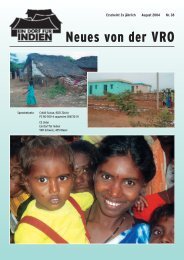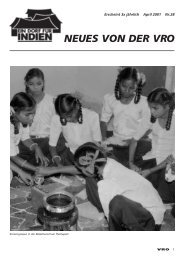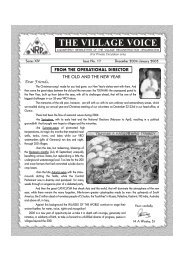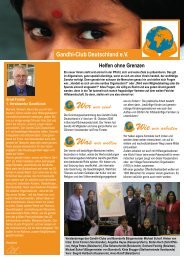+ + Annual Report [2012 â 2013]
+ + Annual Report [2012 â 2013]
+ + Annual Report [2012 â 2013]
You also want an ePaper? Increase the reach of your titles
YUMPU automatically turns print PDFs into web optimized ePapers that Google loves.
Training at Xavier Institute of Management, Bhubaneswar (XIMB) <br />
After the introduction and initiation to the cluster program, the team members attended an intensive training at XIMB, <br />
Bhubaneswar. The team members were trained on the concept of Community Enterprise System (CES) and cluster <br />
approach. A series of theoretical sessions were conducted with the support of various Professors from social work, <br />
communication, sustainable agriculture and marketing departments. Apart from the theory, the team members were <br />
also exposed to a practical experience through an observational visit to Community Enterprise System (CES) at Navajothi <br />
in South Odisha. The Navajothi project was designed and conducted by Prof. Amar J Nayak, who has done intensive work <br />
on Community Enterprise System (CES). He was also the backbone for training and assessing the trainees. He assisted <br />
VRO in framing the cluster project. The training program was organized from 5 th November to 15 th December <strong>2012</strong> with <br />
one-‐week break. The trainers assessed the three cluster teams periodically during the training. <br />
During the one-‐week break, the teams were asked to prepare a tentative plan for the survey and were also asked to get <br />
some basic information about the villages under their respective cluster. In the second half of the training, a planning <br />
meeting was organized during which the decision of not going ahead with the third cluster i.e. Kungabasa Cluster -‐ South <br />
Odisha, was taken. The main reason was that there were not enough tribal trainees to form the third cluster team. <br />
Therefore, only two cluster programs namely, Kothakota Cluster, Andhra Pradesh and Gonsika Cluster, North Odisha <br />
were selected for the year <strong>2013</strong> – 2014. A plan was prepared for the baseline survey and the team members were asked <br />
to do village survey and family survey to assess the various needs such as socio-‐economical, livelihood options, <br />
education, health, civic facilities, etc. A decision on the number of panchayats and villages to be covered under each <br />
cluster was decided. Each cluster covers 2 to 3 Grama Panchayats with a minimum of 20 villages. A final list of the short-listed<br />
team members (list in the appendix) was announced and the members were assigned to their respective cluster. <br />
Field Introduction <br />
The team members started as per plan the rapport building with the community and at the same time they also <br />
identified the needs of the community. The field introduction happened in the month of January, during which the team <br />
members organized village meetings and gave explanation to the villagers about VRO and the cluster approach. Some of <br />
the villages selected under the cluster were already known to VRO through the village-‐rebuilding program. They took <br />
consent from the villagers and requested their participation in the project. After assessing the community participation <br />
into the project a list of villages was prepared and was approved to carry out the base line survey (list in the appendix). <br />
Training at Head Office <br />
The team members from both clusters participated in a training program at Head Office from 4 th to 12 th February. The <br />
purpose of this training was to understand the values and the functioning of VRO and to prepare the baseline survey <br />
format. Mr. Jean Paul, Project Coordinator, organized the training program. The team members were trained on need <br />
assessment, identification of cause-‐effect phenomena of problem, differentiation between problem, need and want, <br />
skills and roles of community worker. The team members were taken to different sites i.e. CCCP, CLC, LLC, WEP, OAH, <br />
etc. to understand the different categories of people that VRO serves and how the problems of each sector of the <br />
community varies. They were also taken to villages to teach them practically about conducting a survey. During the 10 <br />
days training, the team members were given different assignments to practice their skills and identify their role as <br />
community worker. The project coordinator with the help of the team members prepared a baseline survey format. <br />
Baseline Survey <br />
In the month of March, the team members have carried out the baseline survey in their respective clusters. Two formats <br />
for survey viz., village survey and family survey were used to gather the data. The village survey form was used to gather <br />
the data about the village demographics, resources and facilities. The family survey format was used to collect the data <br />
about socio-‐economic condition, livelihood, saving and borrowing pattern, entitlements of each household. Later the <br />
data collected was analyzed using Statistical Package for the Social Sciences (SPSS -‐ a statistical analysis program). By <br />
analyzing the consolidated data, the major problems that need to be addressed were identified and first year plan for <br />
cluster program was prepared. <br />
33


![+ + Annual Report [2012 â 2013]](https://img.yumpu.com/37081838/33/500x640/-annual-report-2012-a-2013.jpg)









